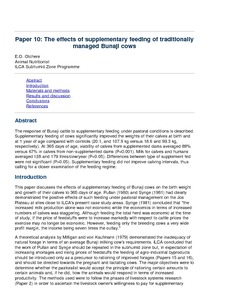Location
Vision, mission and strategy
ILRI's strategy 2013-2022 was approved in December 2012. It emerged from a wide processof consultation and engagement.
ILRI envisions... a world where all people have access to enough food and livelihood options to fulfil their potential.
ILRI’s mission is... to improve food and nutritional security and to reduce poverty in developing countries through research for efficient, safe and sustainable use of livestock—ensuring better lives through livestock.
ILRI’s three strategic objectives are:
- with partners, to develop, test, adapt and promote science-based practices that—being sustainable and scalable—achieve better lives through livestock.
- with partners,to provide compelling scientific evidence in ways that persuade decision-makers—from farms to boardrooms and parliaments—that smarter policies and bigger livestock investments can deliver significant socio-economic, health and environmental dividends to both poor nations and households.
- with partners,to increase capacity among ILRI’s key stakeholders to make better use of livestock science and investments for better lives through livestock.
This is ILRI’s second ten-year strategy. It incorporates a number of changes, many based on learning from the previous strategy (2000–2010, initially produced in 2000 and modified in 2002), an interim strategy (2011–2012) and an assessment of the external and internal environments in which the institute operates.
Members:
Resources
Displaying 1066 - 1070 of 1152The implications of spontaneous range enclosure for African livestock development policy
This paper examines a process - the spontaneous enclosure of the range by livestock owners - which may rise new problems but also permit new approaches to the development of the African livestock industry. Drawing on case material from Sudan and Somalia, the opening section of the paper discusses some of the spontaneous range enclosure.
The performance of stylosanthes species in different production systems in Nigeria
Summarises the performance of three species of stylosanthes, viz, S. guianensis cvs Cook and Schofield, S. hamata cv. Verano and S. humilis under different production systems in Nigeria, such as in pure legume pastures, mixed pastures, with crops, in rangeland and under seed production.
The ecology, vegetation and land use of subhumid Nigeria
Describes the geology, relief, climate, major soil types, vegetation zones and land use patterns of the subhumid zone of Nigeria. Presents results of studies on natural forage productivity & composition and forage production constraints.
The effects of supplementary feeding of traditionally managed Bunaji cows
Describes effects of feeding Bunaji cows supplements of cottonseed cake, molasses-urea or fodder bank on birth & 1-year weight of calves and their viability to 1-year, and milk yield, for both calves & humans, of cows under an agropastoral management system.
Settlement and land use by Fulani pastoralists in case study areas
Presents results of studies of settlement, land use & relations w. settled farmers of Fulani agropastoralists in Abet & Kachia Grazing Reserve in Subhumid Nigeria. Discusses reasons of choice of site, pattern & right of grazing and access to land.






